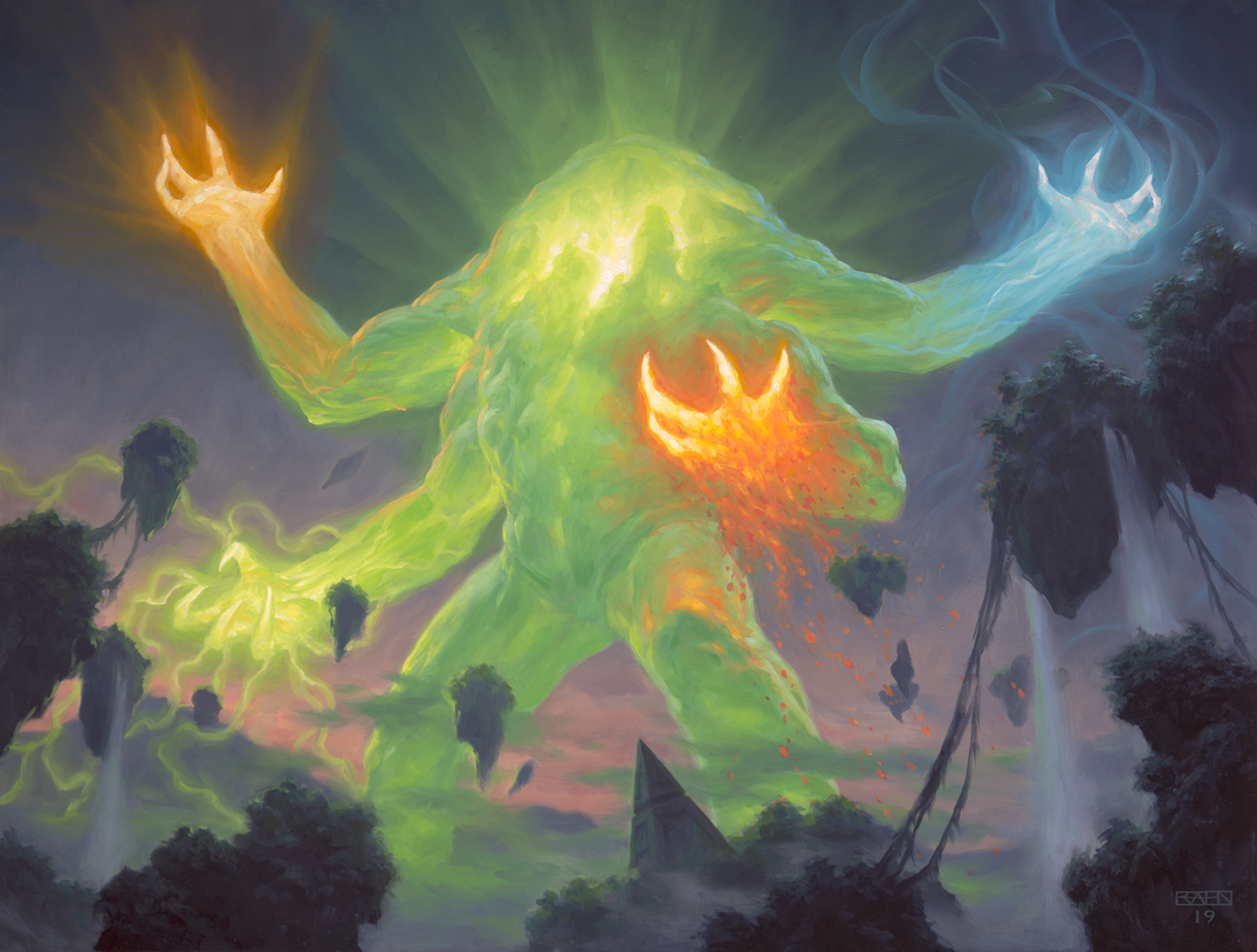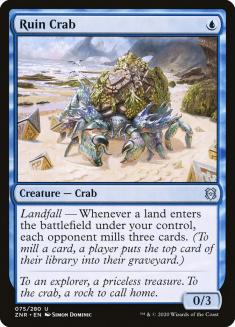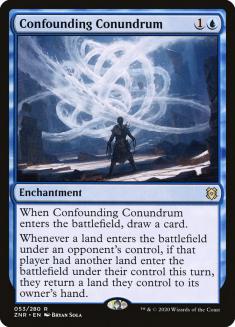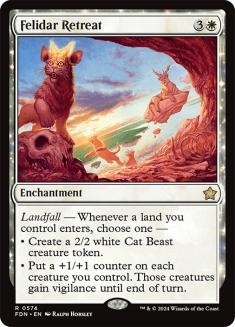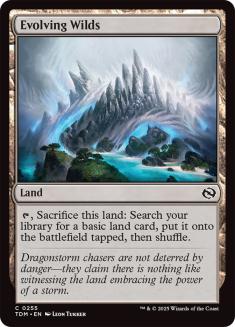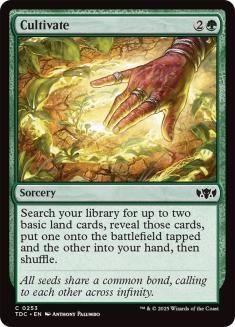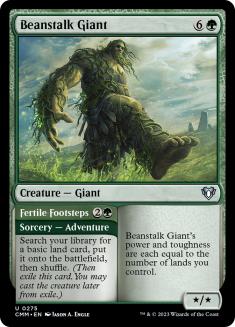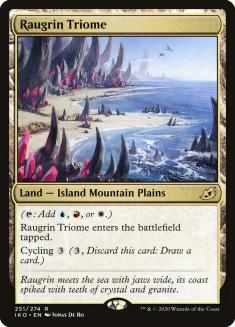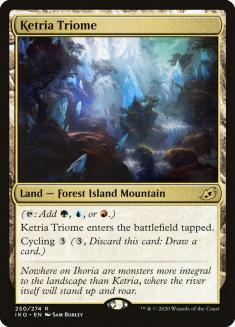At this point in time, it’s clear that Four-Color Ramp is the defining deck of Zendikar Rising Standard. It’s still very early, of course, and the format hasn’t necessarily been put up to the test to the maximum, but this Top 16 from the latest SCG Tour Online Championship Qualifier from this past weekend presents literally the most slanted metagame that I’ve ever seen.
Wizards of the Coast (WotC) identified that this was an issue, so this Monday they released a statement banning Uro, Titan of Nature’s Wrath from Standard.
After the announcement, Magic players took to Twitter to mention how they didn’t actually think this was going to change much, and Omnath decks would still end up dominating. Are they right?
Honestly, I think so. Uro is an incredibly powerful card that definitely helped the deck a lot, but there’s a reason the screenshot names this deck “Four-Color Omnath” and not “Four-Color Uro” — it’s more of a bonus than an integral part of the deck.
Now, don’t get me wrong, the deck is definitely weaker. It’s now possible to interact with it on a one-for-one basis (counterspells or discard spells) and not be buried in Uro card advantage, for example. It’s possible to cast 4/4 or 5/5 creatures and actually attack, and it’s possible to mill them without feeling like you’re digging your own grave (go Rogues!).
Still, as far as killing the deck, this is not going to do it — at least not to the extent that it will kill Sultai Control, which was an actual Uro, Titan of Nature’s Wrath deck. In fact, it hardly seems fair to say that we’re going to be “updating” the deck; I think everyone will just cut Uros for the next-best accelerant, whether that’s Cultivate, Dryad of the Ilysian Grove, or Beanstalk Giant (personally I think Cultivate is the best but you can play more than four). Because of this, I’m going to focus more on the main differences between the builds.
As an aside, it was pointed out that some of the later variations of the deck didn’t even play any Uro (the Magic Online Challenge-winning list played one copy, for example). However, I think even the lists that played zero copies are still hurt by this ban, as the reason they could get away with playing one or zero copies was because everyone else was playing them, and therefore it had to be respected. Were you really going to play Dimir Rogues and hope to get paired versus the one person not running any Uros?
Now that no one can play Uros, some new strategies might emerge that will make you wish you had them. Nevertheless, I believe this is just a small downgrade to the overall power of the deck and it will still remain the top contender in the metagame.
Since the deck is — and I expect it to continue to be — so popular, it makes sense for players to try to find the best version for the mirror (hence a smaller number of Uros as well). The way I see it, there are three possible approaches:
Approach 1 — “We’ll both do our things and I’ll beat you.”
Creatures (18)
- 4 Lotus Cobra
- 1 Uro, Titan of Nature's Wrath
- 2 Dryad of the Ilysian Grove
- 4 Ruin Crab
- 4 Omnath, Locus of Creation
- 3 Glasspool Mimic
Lands (26)
Spells (16)
Sideboard

Creatures (19)
- 4 Lotus Cobra
- 4 Uro, Titan of Nature's Wrath
- 1 Thassa's Oracle
- 4 Dryad of the Ilysian Grove
- 4 Omnath, Locus of Creation
- 2 Glasspool Mimic
Lands (22)
Spells (19)
- 4 Escape to the Wilds
- 4 Genesis Ultimatum
- 3 Bala Ged Recovery
- 4 Spikefield Hazard
- 3 Shatterskull Smashing
- 1 Silundi Vision
Sideboard

These are all-in combo decks that pack minimal interaction. The philosophy behind them is that they’re the best at going off – here, by “going off” I mean casting Omnath, adding a ton of mana, and drawing a large portion of your deck with Escape to the Wilds and Genesis Ultimatum – and when they go off they truly win the game. Since they’re maximized for goldfishing, they’re trying to go off faster than the opponent, but they can still beat someone who went off by just going over what the opponent is doing, as both these win conditions ignore the battlefield and win the game through any number of creatures.
There are some versions here that go a little more “halfway” — they have the ability to win in one turn with Kenrith, the Returned King and/or Terror of the Peaks. Personally, I’m okay with the versions that play one Kenrith as just a way to kill on the same turn, but I don’t think you can play Terror of the Peaks without Uro in your deck, as that makes the card just too bad when you’re not going off, so I’m going to dismiss those versions for now. Incidentally, the Crab version only played one Uro, so it’s hardly hurt by the ban (and may in fact be helped by it as you can no longer accelerate their Uro with your mills).
Of the two versions I posted, I prefer the Ruin Crab one because I think Crab is actually okay at winning the game even if you don’t go off super-hard. The Thassa’s Oracle version will win if it draws its entire deck, and it’s well set up to do that, but the Ruin Crab version will win more games when things don’t go perfectly — sometimes you just cast Crab into Glasspool Mimic and make a bunch of land drops and that’s enough. Plus, I feel that the Oracle version is hurt more by Confounding Conundrum.
The mirror is also a matchup where milling them a little bit can actually be useful. A lot of the time, they need to draw a huge portion of their deck themselves (the deck often ends with sub-twenty cards in the library), so if you mill them a relatively high amount you might make it impossible for them to win, even if you don’t kill them outright. Furthermore, the deck has a lot of basic lands it needs to fetch, so you could gain value by milling those too (if you randomly snipe their Plains, for example, you might make them unable to cast Omnath).
In this regard, having Thassa’s Oracle as your win condition helps a little bit, especially if you can recur it from the graveyard with Bala Ged Recovery. It means you don’t need to go off super-hard to win if they’ve milled you enough, which diminishes the power of the Crab as a “Plan B.” However, Oracle is more of a nuisance than an ultimate trump versus the Crab version, as they can wait to mill your entire deck in one turn.
Approach 2 – “I’ll stop you from doing your thing.”
Creatures (14)
Planeswalkers (3)
Lands (29)
Spells (14)
Sideboard

Creatures (15)
Lands (28)
Spells (17)

These two lists are not as focused on going off as quickly and efficiently as possible, and instead rely on different forms of disruption to slow down the opponent. There’s less need to go over the top of them, because the idea is that they never do what they’re supposed to do to begin with.
Personally, I’m a huge fan of Mystical Dispute in the mirror, but I don’t like Negate very much. Omnath is an integral part of the matchup and having a card that is interaction but doesn’t interact with it in any capacity is very suspicious. I would prefer a more in-between approach, with Disputes but no Negates.
Confounding Conundrum is a very weird card, because it’s the best card you can possibly have versus some draws and an actual negative in others. I’ve had games where my opponent played Conundrum and my hand was all Cultivates and Uros and it really crippled me, but I’ve also had games where I needed a land to play and could only make a land drop because they had Conundrum bouncing a land to my hand.
Overall I thought Conundrum was worth it before, but the Uro ban might have changed things. Uro was the card that made Conundrum useful versus other decks (such as Sultai, which will now become Dimir or Azorius), and it was also one of the cards that were the most punished by Conundrum in the mirrors (I imagine most people will replace them with things like extra Beanstalk Giant or Cultivates, in which case it’ll still be good, but they might also replace them with mana creatures, for example, in which case it’s much worse).
Approach 3: “Whoever goes off first will win regardless, so I’ll just try to have a balanced deck and have a better shot versus everyone else.”
Creatures (17)
- 4 Lotus Cobra
- 3 Beanstalk Giant
- 1 Kenrith, the Returned King
- 4 Uro, Titan of Nature's Wrath
- 1 Terror of the Peaks
- 4 Omnath, Locus of Creation
Lands (29)
Spells (14)

Creatures (11)
Planeswalkers (1)
Lands (27)
Spells (21)

This is a bit of an “in-between” approach and it’s the one that I was adopting before — it has some disruption in the form of Mystical Dispute and removal, but doesn’t go all-in with Negates. It accepts that if a player just goes off, then they will win regardless of what they’re doing because it then gives them the ability to stop the other person from going off with a mix of removal spells and counterspells, so it tries to maximize the other matchups, as well as maximizing the win percentage in the games where things don’t go well for either player.
Personally, I like the version that uses Felidar Retreat as a hedge card. It can still win the game when you go off and they don’t (it easily kills in one turn if you have a couple of attackers), but it’s also quite useful in games where you’re both disrupting each other and no one is going off, since it’s quite low-economy in general (meaning you don’t need a lot going on for it to be good). I find that to be better than both Kenrith and Terror of the Peaks, especially so now that Uro isn’t legal anymore.
Granted, sometimes the battlefield does stall off and then you might lose to someone who is going to deck you with Ruin Crab or kill you with Thassa’s Oracle when you couldn’t break through (it happens and it’s the downside of this version). However, most of the time, if you go off first, you’ll win, even with this version, and you gain a lot everywhere else in return because Felidar Retreat is incredible in some matchups and Ruin Crab is just not a Magic card.
It’s honestly hard to overstate how good Felidar Retreat is against some decks — it can win the game singlehandedly without much support. Versus most control decks, for example, if you resolve it it’s very hard to lose; they just don’t have any answers other than Ugin, the Spirit Dragon. Versus any aggressive deck that plans to attack on the ground (such as Mono-Green Aggro) it can be your entire line of defense by itself and then quickly morph into a win condition.
I completely understand people who don’t want to maindeck Felidar Retreat because of their approach to the mirror match, but if you don’t play it in the maindeck then I’m convinced you should play it in the sideboard. There’s just nothing better against a deck like Dimir Control.
So, which approach should you play? I think it depends on which matchup you value the most — the mirror or all others. I think the Ruin Crab version is the best in the mirror, since it has a clean kill and also steals games by simply casting early Crabs, but it’s also the worst in every other matchup. It’s still a good deck in other matchups, as your good cards can carry you (and Ruin Crab even blocks!), but you’d rather have any of the other stuff.
If the metagame resembles anything like the one we’ve seen lately, then you’re more interested in the mirror than every other matchup combined (for example in the latest SCG Tour Online tournament I played six mirrors in seven rounds). This, to me, would make the Ruin Crab version the optimal to play right now. If the metagame adapts to the Uro ban to a point where other decks are more viable (or a point where people think other decks are more viable), I’d probably go for the Felidar Retreat version, but that’s not the case right now. In any case, I think the other versions are all inferior — I think Crab is just better in the mirror and Felidar Retreat better everywhere else while being decent enough in the mirror, so you just need to choose what your priority is.
This would be my list right now:
Creatures (18)
Lands (26)
Spells (16)
Sideboard

Some specific card choices:
- I like a lot of Evolving Wilds in my decks.
I think you make such good use of landfall that it’s worth having more potential color problems earlier on. The difference between following an Omnath with Evolving Wilds or with a Triome is gigantic, and if you’re playing Crabs and Retreats in the sideboard, I think you really want Evolving Wilds.
- Cultivate over Beanstalk Giant.
I honestly don’t get Beanstalk Giant, unless you’re specifically trying to play it as a big creature to win the game with Kenrith or Terror of the Peaks, but even in that version I find it unnecessary. This deck simply cannot afford to miss land drops and I think giving you a land in hand is worth more than the untapped mana and the chance to play Beanstalk Giant. It’s possible that now, without Uro, you want both, but I’d play the fourth Cultivate before the first Beanstalk Giant and I think Dryad is better than it too for the most part.
- Raugrin Triome over Ketria Triome.
The biggest issue with the deck’s manabase is that you need white mana to cast Omnath, but white mana doesn’t cast Genesis Ultimatum. This is compounded by the fact that you usually want to cast Omnath (and Retreat in some cases) before you make your land drop, so you can’t count on using Fabled Passage or Lotus Cobra to generate your white mana that turn — the white land must already be on the battlefield when you want to cast the Omnath. This means you often need to fetch Plains even when you don’t have Omnath, just so you can cast it and trigger it in the same turn if you draw it, which makes the Ultimatum situation super-awkward.
Because of this, I like Raugrin Triome. It’s a white mana source that casts Ultimatum, so you don’t mind having it on the battlefield. I understand that the deck is heavy green, but for that you can just play Forests or one of the green Pathways, whereas Plains is just really bad to play. Because of this, I like four Raugrin Triomes over the first Ketria Triome (though you can play more than four total if you want).
Four-Color Ramp Isn’t Going Anywhere
Overall it’ll be interesting to see if the metagame can adapt enough to punish the extremely mirror-centric versions of Four-Color Ramp and force players to branch out a little bit — if it does, then I like Felidar Retreat as a card very much. If it doesn’t, I think Ruin Crab is the way to go.

